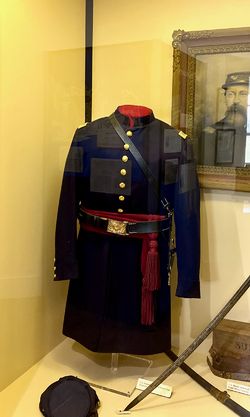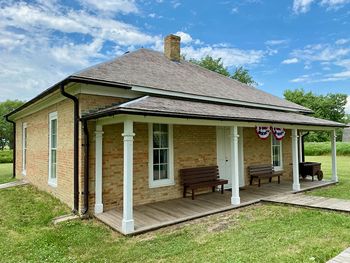Fort Sisseton
| More information at Warlike, Wikidata, Wikipedia
Fort Sisseton (1864-1889) - First established in 1864 as Fort Wadsworth (2) by Major John Clowney as a U.S. Civil War era frontier fort. Initially named after Brigadier General James S. Wadsworth, who was mortally wounded, 8 May 1864, in the Battle of the Wilderness, in Virginia, during the U.S. Civil War. Located near present-day Lake City in Marshall County, South Dakota. Renamed Fort Sisseton, 29 Aug 1876, after the local Sisseton Sioux Indian Tribe. Abandoned in 1889.
HistoryThe original military reservation that was to contain Fort Sisseton was set aside in February 1871 by President Ulysses S. Grant as a 9 by 15 mile, 82,000-acre military reservation. When surveyed by two teams under 1st Lt. Faber it became a five-sided polygon to accommodate a portion of the Lake Traverse Indian Reservation that intersected the area. The boundaries were marked with five iron markers that all survive today, two of which have been relocated to Fort Sisseton and are on display outside the Visitor Center. The fort was established on 1 Aug 1864 as Fort Wadsworth by Major John Clowney, 30th Wisconsin Infantry, as a result of the 1862 Sioux Indian uprising. In 1862 the Sioux tribes seriously underestimated the ability of the U.S. Government to fight the U.S. Civil War and Sioux tribes at the same time. The tribes attacked all along Minnesota frontier and the Dakota Territory, killing settlers and miners wherever they found them. Over 400 settlers were killed on the first day. In August 1862 more than 30,000 people were driven from their homes and 800 settlers were killed by hostile Sioux. The uprising was put down and the surviving Sioux removed to reservations but conflicts continued. Fort Wadsworth was established as one of a number of forts to police the Sioux reservations and enforce the treaties. Strategically located atop a tableland called Coteau des Prairies, the fort was built to respond to any hostile Indian outbreaks and to protect travel routes to the goldfields in Idaho and Montana.                  The fort was constructed on a square plan with a central parade that had the enlisted barracks on the east side, the officer's quarters on the west side, the hospital and school on the north side, and the administrative functions on the south side. Surrounding the post boundary was an earthwork some eight feet high with an outer ditch. A log stockade was originally planned but not built. At the northwest corner of the earthworks, a two-story log blockhouse was built to provide protective fire along flanks of the earthworks. A single-story log blockhouse was also built on the opposite Southeast corner. Inside the earthworks on the south end of the post were a number of log dwellings that housed the Indian scouts and the laundress quarters. The enclosed portion of the post was surrounded on three sides by lakes. Several important buildings were built outside the earthworks, the most important to the personnel at the fort was the Suttler's Trade Store. The Trade Store carried goods and supplies not issued by the military but considered necessary for health, morale, and recreation purposes. Trade store items were purchased by patrons with their own money and the store functioned much like the modern-day PX or BX on nearly all military installations. The Suttler himself was a civilian contract employed with a contract term of three years that operated under a set of rules determined by the post commander. Among the most popular items sold was alcohol. Other buildings outside the earthworks included the stables, blacksmith shops, wagon shed, commissary NCO quarters, roof house, and coal shed. The post was renamed Fort Sisseton on 29 Aug 1876, after the local Sisseton Sioux Indian Tribe, when it was discovered that the original name conflicted with a Fort Wadsworth on Staten Island, New York, also named for BG James S. Wadsworth in 1865. By the 1880s the need for the fort had disappeared and the post was turned over to the Interior Department for disposition 22 April 1889 and abandoned by the Army on 9 Jun 1889.
Current Status    Must See! Fort Sisseton State Park, National Historic Landmark. Restoration of the fort was begun in the 1930s by the Works Progress Administration, WPA, and carried on to date.
See Also: Sources:
Links: Visited: 5-8 Jul 2020 |
|||||||||



